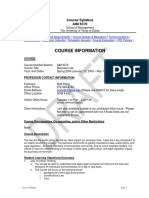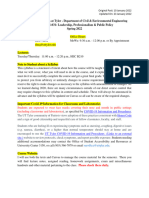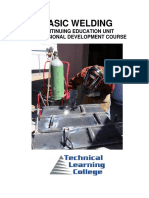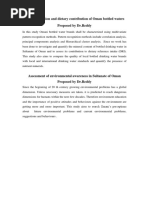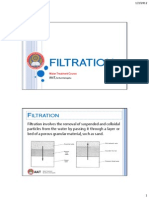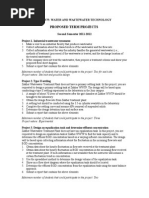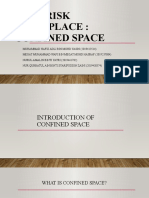Ptac 1308
Ptac 1308
Uploaded by
Sreedhar Reddy SajjalaCopyright:
Available Formats
Ptac 1308
Ptac 1308
Uploaded by
Sreedhar Reddy SajjalaOriginal Description:
Original Title
Copyright
Available Formats
Share this document
Did you find this document useful?
Is this content inappropriate?
Copyright:
Available Formats
Ptac 1308
Ptac 1308
Uploaded by
Sreedhar Reddy SajjalaCopyright:
Available Formats
Safety, Health, and Environment I (PTAC 1308)
Credit: 3 semester credit hours (3 hours lecture)
Prerequisite/Co-requisite: Complete the Online Orientation and
answer yes to 7+ questions on the Online Learner Self-Assessment:
http://www.lit.edu/depts/DistanceEd/OnlineOrientation/OOStep2.aspx
Course Description
Development of knowledge and skills to reinforce the attitudes and behaviors required for
safe and environmentally sound work habits. Emphasis is on safety, health, and
environmental issues in the performance of all job tasks and regulatory compliance
issues. This course is time-=bound, structured, and completed totally online.
Required Textbook and Materials
Safety, Health, and Environment, Pearson Custom Publishing 2006, ISBN number is 0536-25843-0
Course Objectives
Upon completion of this course, the student will be able to:
1. List components of a typical plant safety and environmental program (SCANS
C1.4, C3.3, C5.5, C7.5, C9.4, C12.5, C14.5, C15.5, C18.3, F1.5, F3.3, F4.3, F6.5,
F9.4, F11.4, F13.5, F16.5, F17.5)
2. Describe the role of a process technician in relation to safety, health. (SCANSC
1.4, C3.3, C5.5, C7.5, C9.4, C12.5, C14.5, C15.5, C18.3, F1.5, F3.3, F4.3, F6.5,
F9.4, F11.4, F13.5, F16.5, F17.5
3. Environment; and identify and describe safety, health, and environmental
equipment uses. (SCANSC 1.4, C3.3, C5.5, C7.5, C9.4, C12.5, C14.5, C15.5,
C18.3, F1.5, F3.3 F4.3, F6.5, F9.4, F11.4, F13.5, F16.5, F17.5
SCANS Skills and Competencies
Beginning in the late 1980s, the U.S. Department of Labor Secretarys Commission on
Achieving Necessary Skills (SCANS) conducted extensive research and interviews with
business owners, union leaders, supervisors, and laborers in a wide variety of work
settings to determine what knowledge workers needed in order to perform well on a job.
In 1991, the Commission announced its findings in What Work Requires in Schools. In
its research, the Commission determined that workplace know-how consists of two
elements: foundation skills and workplace competencies.
Approved 01/2010
PTAC 1308 Online
Course Syllabi
Course Outline
A. Introduction
1. Introduction of faculty and students
2. Review Syllabus
3. Review Class Policies
B. Safety, Health, & EnvironmentOverview
1. Different government agencies &
regulations.
2. Industry organizations that develop
S.H.E. standards.
3. Role of the operator in S.H.E.
matters.
C. Hazards and Their Effects
1. Hazards found in work place.
2. Effects of hazards on health.
3. Effects of hazards on environment.
Atmospheric and Respiration Hazards
1. Respiratory hazards.
2. Confined space hazard.
3. Government regulations dealing
with atmospheric & respiratory
hazards.
J.
Work Area and Height Hazards
1. Work area hazard
2. Fall protection and
confined space entry.
3. Government regulations dealing
with work area, fall and confined
space hazards
K. Hearing and Noise Hazards
1. Noise & how it affects hearing.
2. Types of hearing protection
3. Government regulations regulating
noise hazards
D. Chemical Hazards
1. Organic and inorganic chemical
hazards.
2. Introduction to MSDS
L. Construction, Maintenance, & Tool
Hazards
1. Hazards associated with
construction in the process area.
2. Hazards of tools used by process
operators
3. Appropriate government
regulations.
M. Vehicle and Transportation Hazards
1. Forklift, power truck, and other
forms of transportation.
2. Appropriate government
regulations.
E. Biological Hazards
1. Biological hazards in the workplace
2. Role of government relating to
biological hazards.
F. Equipment and Energy Hazards
1. Hazards of process equipment.
2. Hazards caused by energy sources;
i.e. electricity, steam, etc.
G. Fire and Explosive Hazards
1. The fire triangle
2. Government regulations relating to
fire & explosives.
N. Presentations on S.H.E.
1. Presentations of students
2. Discussion of each presentation for
content & application.
H. Pressure, Temperature and Radiation
Hazards
1. Process variable Hazards
2. Government regulations dealing with
process variable hazards.
Grade Scale
90 100
80 89
70 79
I.
A
B
C
2
PTAC 1308 Online
Course Syllabi
60 69
0 59
D
F
Course Evaluation
Final grades will be calculated according to the following criteria:
Participation
10%
Assignments
10%
Tests
65%
Final Exam
15%
Course Requirements
1. Post weekly, online responses to student-to-student and student-to-instructor
discussions.
2. Complete the online test, quizes and assignments by the due dates shown on the
couse calendar
3. Log onto Blackboard and access the course a minimum of three times per week.
Anything less will be recorded as an absence.
Course Policies
1. Students are expected to use proper net etiquette while participating in course
emails, assignment submissions, and online discussions. No foul or harsh
language will be tolerated.
2. No Cheating of any kind will be tolerated. Students caught cheating or helping
someone to cheat can and will be removed from the class for the semester.
Cheating can result in expulsion from LIT.
3. If you wish to drop a course, the student is responsible for initiating and
completing the drop process. If you stop coming to class and fail to drop the
course, you will earn an F in the course.
Technical Requirements
For an online course we recommend the following minimum technology requirements:
Operating System
Windows XP or Vista, MAC OS 10.4 or higher
Processor
1 GHz or higher
Memory
256 MB of RAM
If running Vista: 512 MB of RAM
Hard Drive Space
500 MB free disk space
Browser
Windows:
Supported:
3
PTAC 1308 Online
Course Syllabi
Internet Explorer 6.0
Internet Explorer 7.0
Firefox 2.0
Unsupported Browsers:
Internet Explorer 8
Firefox 3.0
MAC 0S 10.4, 10.5:
Supported:
Safari 3.0
Safari 3.1
Firefox 2.0
Unsupported Browsers
Safari 3.2
Firefox 3.0
Note: Cookies, Java, and JavaScript must be enabled. Pop-up
blockers should be configured to permit new windows from LIT
Click here to check your browser.
Browser Plug-ins
In addition to the minimum system requirements needed to
access Blackboard, you may also need additional browser plugins to view some of the content.
Common plug-ins include:
Adobe Acrobat
Adobe Flash Player
Quicktime
Windows Media Player
Internet Connection
Broadband (cable or DSL) connection required
Additional Software
You should be running the most recent version of Java.
PTAC 1308 Online
Course Syllabi
Disabilities Statement
The Americans with Disabilities Act of 1992 and Section 504 of the Rehabilitation Act of
1973 are federal anti-discrimination statutes that provide comprehensive civil rights for
persons with disabilities. Among other things, these statutes require that all students with
documented disabilities be guaranteed a learning environment that provides for
reasonable accommodations for their disabilities. If you believe you have a disability
requiring an accommodation, please contact the Special Populations Coordinator at (409)
880-1737, visit the office in Student Services, Cecil Beeson Building or visit the online
resource: http://www.lit.edu/depts/stuserv/special/default.aspx
Course Schedule
Week
1&2
Topic
Course Orientation Introductions, Syllabus,
Learning environment orientation
Chapter 1 Introduction to SHE
3
4
5
6
7
8
9
10
11
12
13
14
15
Chapter 2 Types of Hazards and their Effects
Due: Safety Talk Paper
Chapter 3 Recognizing Chemical Hazards
TEST 1 (Chapters 1 3)
Chapter 4 Recognizing Biological Hazards
Due: MSDS Sheet paper
Chapter 5 Equipment and Energy Hazards
Chapters 6 Fire and Explosion Hazards
Visuals
TEST 2 (Chapters 4 6)
Chapter 7 Pressure, Temperature, and
Radiation Hazards
Chapters 8 Hazardous Atmospheres and
Respirator Hazards
Chapter 9 Working Area and Height Hazards
TEST 3 (Chapters 7 9)
Chapter 10 Hearing and Noise Hazards
Chapter 11 Construction, maintenance, and
Tool Hazards
Chapters 12 Vehicle and Transportation
Hazards
5
Reference
Syllabus
Netiquette link
Discussion Thread
Lesson 1 Reading
Discussion Thread
Lesson 2 Reading
Lesson 3 Reading
Discussion Thread
Lesson 4 Reading
Lesson 5 Reading
Lesson 6 Reading
Term Paper Due
PTAC 1308 Online
Course Syllabi
16
FINAL (Chapters 1 12)
You might also like
- Method Statement For Field Erection Storage TanksDocument29 pagesMethod Statement For Field Erection Storage TanksTee Klong Rung100% (1)
- Confined Spaces Risk Assessment TemplateDocument1 pageConfined Spaces Risk Assessment Templatemkashkooli_scribdNo ratings yet
- JSA G02 Lift Personnel in Scissor LiftDocument6 pagesJSA G02 Lift Personnel in Scissor Liftjokerseri100% (3)
- Sydney Safety Confined Space Rescue PlanDocument4 pagesSydney Safety Confined Space Rescue PlanFranscois Van RooyenNo ratings yet
- Syllabus - EECS3093C Version 2Document11 pagesSyllabus - EECS3093C Version 2emad abougabalNo ratings yet
- Civl375 Experiment 5 Removal of Hardness by Lime and Soda-AshDocument6 pagesCivl375 Experiment 5 Removal of Hardness by Lime and Soda-AshSreedhar Reddy SajjalaNo ratings yet
- Aramco Interview Q&ADocument47 pagesAramco Interview Q&ASabarish100% (2)
- Endo PR Fall 2020 SyllabusDocument8 pagesEndo PR Fall 2020 SyllabusKeenan SmithNo ratings yet
- 2334 Syllabus 2013 SpringDocument5 pages2334 Syllabus 2013 SpringIsmaael AcostaNo ratings yet
- Either Michael or Chris May Also Be Available at Other Times by AppointmentDocument7 pagesEither Michael or Chris May Also Be Available at Other Times by AppointmentbillcosbyssweaterNo ratings yet
- SyllabusDocument5 pagesSyllabusChandan Prasai100% (1)
- Georgia Piedmont Technical College Introduction To Network Course Cist 1401 CRN 50861 Semester Fall 2012 Outline, Syllabus, & Orientation InformationDocument7 pagesGeorgia Piedmont Technical College Introduction To Network Course Cist 1401 CRN 50861 Semester Fall 2012 Outline, Syllabus, & Orientation InformationjaunsdasdNo ratings yet
- HESC 450 Syllabus - Spring 2015 Online AccessibilityDocument13 pagesHESC 450 Syllabus - Spring 2015 Online AccessibilityCatarina NguyenNo ratings yet
- Accounting Information Systems AC 330 Section A Course Syllabus Spring 2012Document6 pagesAccounting Information Systems AC 330 Section A Course Syllabus Spring 2012FikaCharistaNo ratings yet
- Course Syllabus ACCT 6335-Ethics For Professional AccountantsDocument6 pagesCourse Syllabus ACCT 6335-Ethics For Professional AccountantscdorwishNo ratings yet
- UT Dallas Syllabus For Aim6370.p0d.09s Taught by Matthew Polze (mmp062000)Document14 pagesUT Dallas Syllabus For Aim6370.p0d.09s Taught by Matthew Polze (mmp062000)UT Dallas Provost's Technology GroupNo ratings yet
- UT Dallas Syllabus For cs4485.001.08s Taught by I-Ling Yen (Ilyen)Document6 pagesUT Dallas Syllabus For cs4485.001.08s Taught by I-Ling Yen (Ilyen)UT Dallas Provost's Technology GroupNo ratings yet
- UT Dallas Syllabus For Entp6375.0g1.10f Taught by Daniel Bochsler (dcb091000)Document19 pagesUT Dallas Syllabus For Entp6375.0g1.10f Taught by Daniel Bochsler (dcb091000)UT Dallas Provost's Technology GroupNo ratings yet
- Fina-4332 001Document7 pagesFina-4332 001Kiều Thảo AnhNo ratings yet
- UT Dallas Syllabus For Entp6375.0g1.10f Taught by Daniel Bochsler (dcb091000)Document20 pagesUT Dallas Syllabus For Entp6375.0g1.10f Taught by Daniel Bochsler (dcb091000)UT Dallas Provost's Technology GroupNo ratings yet
- (Fall 2013, CRN:, 3 Credits) Location & Time: FL 409, T 4:00pm-6:50pmDocument7 pages(Fall 2013, CRN:, 3 Credits) Location & Time: FL 409, T 4:00pm-6:50pmloay1alshamiNo ratings yet
- MIS 64271 SyllabusDocument11 pagesMIS 64271 Syllabusalin10No ratings yet
- CSE 2312 Syllabus, Fall 2017: Course DescriptionDocument3 pagesCSE 2312 Syllabus, Fall 2017: Course DescriptionIshan PoudelNo ratings yet
- COIT13229 Course ProfileDocument9 pagesCOIT13229 Course ProfileNivin JoseNo ratings yet
- BA63274 G420 Online Syllabus v5Document16 pagesBA63274 G420 Online Syllabus v5Jayaram KarumuriNo ratings yet
- Ceng4341 031 Huq Spring2022Document9 pagesCeng4341 031 Huq Spring2022Srour NofalNo ratings yet
- EEL2000 Introduction To Electrical EngineeringDocument3 pagesEEL2000 Introduction To Electrical Engineeringebook4download2228No ratings yet
- UT Dallas Syllabus For Aim6352.0g1.11s Taught by Kenneth Bressler (Bressler)Document13 pagesUT Dallas Syllabus For Aim6352.0g1.11s Taught by Kenneth Bressler (Bressler)UT Dallas Provost's Technology GroupNo ratings yet
- GaBBA - CPTR 105 - Introduction To Computers - Rev3Document5 pagesGaBBA - CPTR 105 - Introduction To Computers - Rev3Tú NguyễnNo ratings yet
- Amsalam@uncg - Edu: This Will Help Me Organize and Respond To Your Problems QuickerDocument6 pagesAmsalam@uncg - Edu: This Will Help Me Organize and Respond To Your Problems QuickerMD. LEONNo ratings yet
- BSAD 153-Spring 2021-Block 1-Section 2Document4 pagesBSAD 153-Spring 2021-Block 1-Section 2ConnorNo ratings yet
- Spring 2023 BSC 2010 708347 INTRO BIO IDocument23 pagesSpring 2023 BSC 2010 708347 INTRO BIO IbamahabirNo ratings yet
- CS4443 XTIA - TSU Web-Based Software Development (Xiaoli Huan)Document7 pagesCS4443 XTIA - TSU Web-Based Software Development (Xiaoli Huan)canadaspiritNo ratings yet
- CSC110 Syllabus - Spring 2014Document6 pagesCSC110 Syllabus - Spring 2014Salome PNo ratings yet
- MIS 3330-Information System Concepts (Fall 2009 - 3 Credits)Document5 pagesMIS 3330-Information System Concepts (Fall 2009 - 3 Credits)BADDSHAHNo ratings yet
- Eco3cce Extended SLG 2014Document14 pagesEco3cce Extended SLG 2014Huong TranNo ratings yet
- EE223 OBE RevisedDocument6 pagesEE223 OBE RevisedMichael Calizo PacisNo ratings yet
- Accounting Information System SyllabusDocument4 pagesAccounting Information System SyllabusKemas DestiaNo ratings yet
- Rad 101 SyllabusDocument11 pagesRad 101 Syllabusapi-260701645No ratings yet
- 3 - Ictict532 At2 Pe TQM v1Document6 pages3 - Ictict532 At2 Pe TQM v1shiva KumarNo ratings yet
- CIS8080SYLF11Document10 pagesCIS8080SYLF11adityaScribd333No ratings yet
- EE 209 Sp2014 Tarng SyllabusDocument8 pagesEE 209 Sp2014 Tarng Syllabuschaitu3318No ratings yet
- Puckett ECO151I02 SP2022Document4 pagesPuckett ECO151I02 SP2022Chase FarnitanoNo ratings yet
- UT Dallas Syllabus For Aim6334.0g1.11s Taught by Tiffany Bortz (Tabortz)Document9 pagesUT Dallas Syllabus For Aim6334.0g1.11s Taught by Tiffany Bortz (Tabortz)UT Dallas Provost's Technology GroupNo ratings yet
- CNC Computer Numerical Control Programmig BasicsDocument151 pagesCNC Computer Numerical Control Programmig Basicscaeiro60No ratings yet
- Systems Security-BIC3263 - Course OutlineDocument9 pagesSystems Security-BIC3263 - Course OutlineBorotho MolemoNo ratings yet
- ACC 373 - Introduction To Auditing and Assurance Services PDFDocument8 pagesACC 373 - Introduction To Auditing and Assurance Services PDFAlex ChanNo ratings yet
- Advanced Networking and Communication Systems CSIS 430 CGDocument6 pagesAdvanced Networking and Communication Systems CSIS 430 CGArun KumarNo ratings yet
- 2016-2017 Ammt SyllabusDocument5 pages2016-2017 Ammt Syllabusapi-327427506No ratings yet
- NOBOSH Intl DIPLOMADocument14 pagesNOBOSH Intl DIPLOMACezar Dumitriu100% (1)
- Iot Fall 2021Document10 pagesIot Fall 2021dina alostathNo ratings yet
- Syllabus - Tics in HealthcareDocument2 pagesSyllabus - Tics in HealthcarebmstokesNo ratings yet
- Edited Adm Smaw m3Document21 pagesEdited Adm Smaw m3markNo ratings yet
- Bldg1077 - Construction Health and Safety, Page 1/10 © 2019 George BrownDocument10 pagesBldg1077 - Construction Health and Safety, Page 1/10 © 2019 George BrownPmNo ratings yet
- SyllabusDocument7 pagesSyllabusapi-273079119No ratings yet
- Is3220 IgDocument120 pagesIs3220 Iglindon21No ratings yet
- School of Information and Communication Technology College of Sciences and Engineering Unit Outline KIT613 Human Computer InteractionDocument12 pagesSchool of Information and Communication Technology College of Sciences and Engineering Unit Outline KIT613 Human Computer InteractionShahid AhmedNo ratings yet
- Flocculation PDFDocument557 pagesFlocculation PDFandre setiawanNo ratings yet
- UT Dallas Syllabus For Ee4361.001 06f Taught by Issa Panahi (Imp015000)Document6 pagesUT Dallas Syllabus For Ee4361.001 06f Taught by Issa Panahi (Imp015000)UT Dallas Provost's Technology GroupNo ratings yet
- Applied Data Analytics With PythonDocument14 pagesApplied Data Analytics With PythonhoangtucuagioNo ratings yet
- Basic Welding: Continuing Education Unit Professional Development CourseDocument151 pagesBasic Welding: Continuing Education Unit Professional Development CourseIfeanyi Henry NjokuNo ratings yet
- DI108 Introduction To Internet and Mobile Technologies: Unit Information and Learning GuideDocument15 pagesDI108 Introduction To Internet and Mobile Technologies: Unit Information and Learning GuidevvunitedNo ratings yet
- UT Dallas Syllabus For Ecsc4378.091.10f Taught by Jerry Alexander (Jda071000)Document6 pagesUT Dallas Syllabus For Ecsc4378.091.10f Taught by Jerry Alexander (Jda071000)UT Dallas Provost's Technology GroupNo ratings yet
- CS127-Problem Solving and Programming 2-Syllabus 2012-ITDocument5 pagesCS127-Problem Solving and Programming 2-Syllabus 2012-ITJohnNo ratings yet
- CMPE 148 S14 FatoohiDocument6 pagesCMPE 148 S14 FatoohiShanmuganathanTrNo ratings yet
- Characterization and Dietary Contribution of Oman Bottled Waters Proposed by DR - ReddyDocument1 pageCharacterization and Dietary Contribution of Oman Bottled Waters Proposed by DR - ReddySreedhar Reddy SajjalaNo ratings yet
- E-Waste DR - Reddy NewDocument46 pagesE-Waste DR - Reddy NewSreedhar Reddy SajjalaNo ratings yet
- Topic: Physical Unit Operation-Screening, Grit Removal, EqualizationDocument49 pagesTopic: Physical Unit Operation-Screening, Grit Removal, EqualizationSreedhar Reddy SajjalaNo ratings yet
- Plants Used in The Study: Materials and MethodsDocument4 pagesPlants Used in The Study: Materials and MethodsSreedhar Reddy SajjalaNo ratings yet
- Most Probable NumberDocument1 pageMost Probable NumberSreedhar Reddy SajjalaNo ratings yet
- All The Experiment Will Be Completed by 31/4/2015Document2 pagesAll The Experiment Will Be Completed by 31/4/2015Sreedhar Reddy SajjalaNo ratings yet
- Hydrology & HydraulicsDocument3 pagesHydrology & HydraulicsSreedhar Reddy SajjalaNo ratings yet
- Example Final ExamDocument6 pagesExample Final ExamSreedhar Reddy SajjalaNo ratings yet
- Poster Moza SodisDocument1 pagePoster Moza SodisSreedhar Reddy SajjalaNo ratings yet
- WT Chapter 6 2Document21 pagesWT Chapter 6 2kanchanabalajiNo ratings yet
- Disinfection of Falaj Water Using Solar Water Disinfection (Sodis)Document1 pageDisinfection of Falaj Water Using Solar Water Disinfection (Sodis)Sreedhar Reddy SajjalaNo ratings yet
- Time Table: Nam: Dr. S.Sreedhar Reddy SemesterDocument1 pageTime Table: Nam: Dr. S.Sreedhar Reddy SemesterSreedhar Reddy SajjalaNo ratings yet
- Hydrology & HydraulicsDocument3 pagesHydrology & HydraulicsSreedhar Reddy SajjalaNo ratings yet
- Section 1: GC Wastewater BS TS PS AT SSDocument6 pagesSection 1: GC Wastewater BS TS PS AT SSSreedhar Reddy SajjalaNo ratings yet
- Disinfection: ObjectiveDocument8 pagesDisinfection: ObjectiveSreedhar Reddy SajjalaNo ratings yet
- Suggested Term Projects 2nd-2011-2012Document4 pagesSuggested Term Projects 2nd-2011-2012Sreedhar Reddy SajjalaNo ratings yet
- Sorption and Ion ExchangeDocument15 pagesSorption and Ion ExchangeSreedhar Reddy SajjalaNo ratings yet
- CIVL375: Water and Wastewater TechnologyDocument3 pagesCIVL375: Water and Wastewater TechnologySreedhar Reddy SajjalaNo ratings yet
- Chapter 1Document9 pagesChapter 1Sreedhar Reddy SajjalaNo ratings yet
- Workplace Safety & Health Guidelines: Service Allied To The Transport of GoodsDocument54 pagesWorkplace Safety & Health Guidelines: Service Allied To The Transport of Goodsdcf67myNo ratings yet
- Bunker Fuel Oil SDSDocument17 pagesBunker Fuel Oil SDSEd JosefNo ratings yet
- Safety Golden RulesDocument7 pagesSafety Golden RulesRicardo Alcantar Escalera100% (1)
- Supervisors - HSE ChecklistDocument2 pagesSupervisors - HSE Checklistchikkam50% (4)
- Dokumen - Tips Zeto RulesDocument30 pagesDokumen - Tips Zeto RulesmohdchemustafhaNo ratings yet
- CPCCCM2007B Student Final Assessment Submission EvidenceDocument36 pagesCPCCCM2007B Student Final Assessment Submission Evidencemishal chNo ratings yet
- Hirarc 2Document5 pagesHirarc 2dibhmNo ratings yet
- 01.HSE Assurance KeysDocument11 pages01.HSE Assurance KeysMuhammad ShakeelNo ratings yet
- Confined Space PermitDocument1 pageConfined Space PermitNethiyaaRajendranNo ratings yet
- Confined - Spaced EntryDocument22 pagesConfined - Spaced EntryDanny SardiniaNo ratings yet
- Confined Space EntryDocument2 pagesConfined Space Entryaudit jogiNo ratings yet
- Ohs Nokia PDFDocument9 pagesOhs Nokia PDFAakash Saurabh0% (1)
- Excavations OSHA Competent Person Course 1Document33 pagesExcavations OSHA Competent Person Course 1MelchezadekNo ratings yet
- Model Confined Space Plan TemplateDocument12 pagesModel Confined Space Plan TemplateGeneral CommunicationNo ratings yet
- G+ Safe by Design Workshop Report: WTG Access To The Transition Piece (Below Airtight Deck)Document37 pagesG+ Safe by Design Workshop Report: WTG Access To The Transition Piece (Below Airtight Deck)romedic36No ratings yet
- Pre-Tender S&H Plan GuidanceDocument7 pagesPre-Tender S&H Plan Guidancepeter472351No ratings yet
- ENO JHA SHELL 001 - Cutting and Excavation Work at None - Hazardous AreaDocument4 pagesENO JHA SHELL 001 - Cutting and Excavation Work at None - Hazardous Areamyn maliQue0% (1)
- WMS Panel Assessment QuestionsDocument15 pagesWMS Panel Assessment Questionslutayamed1No ratings yet
- Che 136Document21 pagesChe 136Qurratulain SyarifuddinzainiNo ratings yet
- IGC-1 NotesDocument39 pagesIGC-1 Noteskhurram67% (6)
- Bending MachineDocument52 pagesBending MachineFarrukh AhmedNo ratings yet
- Confined Space Entry Training - PPT BabtainDocument91 pagesConfined Space Entry Training - PPT BabtainKh Mo0% (1)
- JOB HAZARD ANALYSIS (Cleaning) .Document17 pagesJOB HAZARD ANALYSIS (Cleaning) .Ali ImamNo ratings yet
- Deck MaintenanceDocument26 pagesDeck MaintenanceMeleti Meleti MeletiouNo ratings yet
- Safety InductionDocument57 pagesSafety Inductionlahmar asmaNo ratings yet















